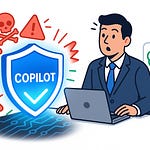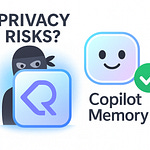Everyone thinks Microsoft Copilot is just “turn it on and magic happens.” Wrong. What you’re actually doing is plugging a large language model straight into the bloodstream of your company data. Enter Copilot: it combines large language models with your Microsoft Graph content and the Microsoft 365 apps you use every day.
Emails, chats, documents—all flowing in as inputs. The question isn’t whether it works; it’s what else you just unleashed across your tenant. The real stakes span contracts, licenses, data protection, technical controls, and governance. Miss a piece, and you’ve built a labyrinth with no map.
So be honest—what exactly flips when you toggle Copilot, and who’s responsible for the consequences of that flip?
Contracts: The Invisible Hand on the Switch
Contracts: the invisible hand guiding every so-called “switch” you think you’re flipping. While the admin console might look like a dashboard of power, the real wiring sits in dry legal text. Copilot doesn’t stand alone—it’s governed under the Microsoft Product Terms and the Microsoft Data Protection Addendum. Those documents aren’t fine print; they are the baseline for data residency, processing commitments, and privacy obligations. In other words, before you press a single toggle, the contract has already dictated the terms of the game.
Let’s strip away illusions. The Microsoft Product Terms determine what you’re allowed to do, where your data is physically permitted to live, and—crucially—who owns the outputs Copilot produces. The Data Protection Addendum sets privacy controls, most notably around GDPR and similar frameworks, defining Microsoft’s role as data processor. These frameworks are not inspirational posters for compliance—they’re binding. Ignore them, and you don’t avoid the rules; you simply increase the risk of non-compliance, because your technical settings must operate in step with these obligations, not in defiance of them.
This isn’t a technicality—it’s structural. Contracts are obligations; technical controls are the enforcement mechanisms. You can meticulously configure retention labels, encryption policies, and permissions until you collapse from exhaustion, but if those measures don’t align with the commitments already codified in the DPA and Product Terms, you’re still exposed. A contract is not something you can “work around.” It’s the starting gun. Without that, you’re not properly deployed—you’re improvising with legal liabilities.
Here’s one fear I hear constantly: “Is Microsoft secretly training their LLMs on our business data?” The contractual answer is no. Prompts, responses, and Microsoft Graph data used by Copilot are not fed back into Microsoft’s foundation models. This is formalized in both the Product Terms and the DPA. Your emails aren’t moonlighting as practice notes for the AI brain. Microsoft built protections to stop exactly that. If you didn’t know this, congratulations—you were worrying about a problem the contract already solved.
Now, to drive home the point, picture the gym membership analogy. You thought you were just signing up for a treadmill. But the contract quietly sets the opening hours, the restrictions on equipment, and yes—the part about wearing clothes in the sauna. You don’t get to say you skipped the reading; the gym enforces it regardless. Microsoft operates the same way. Infrastructure and legal scaffolding, not playground improvisation.
These agreements dictate where data resides. Residency is no philosopher’s abstraction; regulators enforce it with brutal clarity. For example, EU customers’ Copilot queries are constrained within the EU Data Boundary. Outside the EU, queries may route through data centers in other global regions. This is spelled out in the Product Terms. Surprised to learn your files can cross borders? That shock only comes if you failed to read what you signed. Ownership of outputs is also handled upfront. Those slide decks Copilot generates? They default to your ownership not because of some act of digital generosity, but because the Product Terms instructed the AI system to waive any claim to the IP.
And then there’s GDPR and beyond. Data breach notifications, subprocessor use, auditing—each lives in the DPA. The upshot isn’t theoretical. If your rollout doesn’t respect these dependencies, your technical controls become an elaborate façade, impressive but hollow. The contract sets the architecture, and only then do the switches and policies you configure carry actual compliance weight.
The metaphor that sticks: think of Copilot not as an electrical outlet you casually plug into, but as part of a power grid. The blueprint of that grid—the wiring diagram—exists long before you plug in the toaster. Get the diagram wrong, and every technical move after creates instability. Contracts are that wiring diagram. The admin switch is just you plugging in at the endpoint.
And let’s be precise: enabling a user isn’t just a casual choice. Turning Copilot on enacts the obligations already coded into these documents. Identity permissions, encryption, retention—all operate downstream. Contractual terms are governance at its atomic level. Before you even assign a role, before you set a retention label, the contract has already settled jurisdiction, ownership, and compliance posture.
So here’s the takeaway: before you start sprinkling licenses across your workforce, stop. Sit down with Legal. Verify that your DPA and Product Terms coverage are documented. Map out any region-specific residency commitments—like EU boundary considerations—and baseline your obligations. Only then does it make sense to let IT begin assigning seats of Copilot.
And once the foundation is acknowledged, the natural next step is obvious: beyond the paperwork, what do those licenses and role assignments actually control when you switch them on? That’s where the real locks start to appear.
Licenses & Roles: The Locks on Every Door
Licenses & Roles: The Locks on Every Door. You probably think a license is just a magic key—buy one, hand it out, users type in prompts, and suddenly Copilot is composing emails like an over-caffeinated intern. Incorrect. A Copilot license isn’t a skeleton key; it’s more like a building permit with a bouncer attached. The permit defines what can legally exist, and the bouncer enforces who’s allowed past the rope. Treat licensing as nothing more than an unlock code, and you’ve already misunderstood how the system is wired.
Here’s the clarification you need to tattoo onto your brain: licenses enable Copilot features, but Copilot only surfaces data a user already has permission to see via Microsoft Graph. Permissions are enforced by your tenant’s identity and RBAC settings. The license says, “Yes, this person can use Copilot.” But RBAC says, “No, they still can’t open the CFO’s private folders unless they could before.” Without that distinction, people panic at phantom risks or, worse, ignore the very real ones.
Licensing itself is blunt but necessary. Copilot is an add-on to existing Microsoft 365 plans. It doesn’t come pre-baked into standard bundles, you opt in. Assigning a license doesn’t extend permissions—it simply grants the functionality inside Word, Excel, Outlook, and the rest of the suite. And here’s the operational nuance: some functions demand additional licensing, like Purview for compliance controls or Defender add-ons for security swing gates. Try to run Copilot without knowing these dependencies, and your rollout is about as stable as building scaffolding on Jell-O.
Now let’s dispel the most dangerous misconception. If you assign Copilot licenses carelessly—say, spray them across the organization without checking RBAC—users will be able to query anything they already have access to. That means if your permission hygiene is sloppy, the intern doesn’t magically become global admin, but they can still surface sensitive documents accidentally left open to “Everyone.” When you marry broad licensing with loose roles, exposure isn’t hypothetical, it’s guaranteed. Users don’t need malicious intent to cause leaks; they just need a search box and too much inherited access.
Roles are where the scaffolding holds. Role-based access control decides what level of access an identity has. Assign Copilot licenses without scoping roles, and you’re effectively giving people AI-augmented flashlights in dark hallways they shouldn’t even be walking through. Done right, RBAC keeps Copilot fenced in. Finance employees can only interrogate financial datasets. Marketing can only generate drafts from campaign material. Admins may manage settings, but only within the strict boundaries you’ve drawn. Copilot mirrors the directory faithfully—it doesn’t run wild unless your directory already does.
Picture two organizations. The first believes fairness equals identical licenses with identical access. Everyone gets the same Copilot scope. Noble thought, disastrous consequence: Copilot now happily dives into contract libraries, HR records, and executive email chains because they were accidentally left overshared. The second follows discipline. Licenses match needs, and roles define strict zones. Finance stays fenced in finance, marketing stays fenced in marketing, IT sits at the edge. Users still feel Copilot is intelligent, but in reality it’s simply reflecting disciplined information architecture.
Here’s a practical survival tip: stop manually assigning seats seat by seat. Instead, use group-based license assignments. It’s efficient, and it forces you to review group memberships. If you don’t audit those memberships, licenses can spill into corners they shouldn’t. And remember, Copilot licenses cannot be extended to cross-tenant guest accounts. No, the consultant with a Gmail login doesn’t get Copilot inside your environment. Don’t try to work around it. The system will block you, and for once that’s a gift.
Think of licenses as passports. They mark who belongs at the border. But passports don’t guarantee citizens free run across the continent; visas and resident permits add the restrictions. Roles are your visas. Together, they structure borders. Ignore roles, and you’re the tourist loudly demanding citizenship at immigration—amusing at best, dangerous at worst.
The elegance here is that RBAC, when architected correctly, becomes invisible. Users think Copilot “knows” them. Not true. Copilot simply echoes the security lattice already built into Microsoft 365. Provide strong permissions, and Copilot mirrors discipline. Provide chaos, and Copilot mirrors chaos. The mirror is neutral; your design is not.
That’s why licenses and roles together function as silent locks across your organization. Done properly, no one notices. Done poorly, you only notice once Copilot begins surfacing documents no intern should ever read. And that raises the next problem—inside those locked rooms, what is Copilot actually consuming? The answer: a buffet made up of your emails, your documents, and every forgotten overshared file you’ve left lying around.
Data Exposure: Copilot’s Diet is Your Entire Org
So let’s talk about what happens once Copilot starts chewing. Data exposure isn’t theoretical—it’s the everyday consequence of Copilot being allowed to “eat” from the very same directory you’ve constructed. Microsoft 365 Copilot sources content through Microsoft Graph and only presents material a user already has at least view permissions for. The semantic index and grounding respect identity-based access boundaries. Which means the AI is not wandering into vaults it shouldn’t—it’s simply pointing out what your security model already makes visible, often in ways you didn’t expect.
And yet, that’s the danger. Copilot doesn’t bend permissions, it mirrors them. If your Teams libraries are riddled with “Everyone” access, Copilot is going to happily pull those into a summary. If your SharePoint is sloppily exposed, Copilot will integrate that data into drafts. Users rarely go searching for the messy corners of your tenant, but Copilot doesn’t discriminate. It fetches from the entire index. And the index is your doing, not Microsoft’s.
Think of Copilot as a librarian with perfect recall. Traditional employees forget the unlocked filing cabinet in the basement. Copilot doesn’t forget—it scans the index. The embarrassing memo you dumped in a wide-open folder is no longer forgotten; it’s prompt-ready. Again, not malice. Just efficiency applied to whatever digital chaos you built.
Now, permissions alone aren’t the whole equation. Enter sensitivity labels. These aren’t decoration—they drive protection. When a file is labeled as “Confidential” with encryption enforced, Copilot must respect it. And here’s the precise detail: when labels enforce encryption or require EXTRACT usage rights, Copilot only processes content if the user has both VIEW and EXTRACT permissions. If not, Copilot is blocked. Labels are inherited, too. So when Copilot generates a new slide deck based on a sensitive file, the label and protections carry over automatically. No human intervention required. That’s a good thing, because if you depend on end users remembering to label every derivative document, you’re trusting humans against entropy. Statistically, they lose.
Regulatory frameworks amplify this. GDPR does not care that “the permissions allowed it.” HIPAA doesn’t care that someone accidentally left cancer patient records open to a marketing team. ISO doesn’t shrug when processes are inconsistent. Regulators care about access surfaces—period. If your permission setup allows personal data to appear via Copilot, then your compliance posture is compromised. Claiming “but the AI just reflected permissions” is like arguing you shouldn’t get a speeding ticket because your foot naturally pushed the gas pedal. Laws disagree.
And don’t oversimplify the residency rules either. For EU customers, Microsoft routes Copilot processing through the EU Data Boundary where required. But—and this is critical—web search queries to Bing are not included in the EUDB guarantees. They follow a separate data-handling policy altogether. Assume all data is shielded equally and you’re already wrong. Regulators will notice the nuance, even if you didn’t bother to read it.
What about persistence? Copilot prompts, responses, and activity logs aren’t floating off into some LLM training facility. They’re stored inside the Microsoft 365 service boundary, where retention and deletion can be managed—with Purview, of course. Admins can use Purview content search and retention policies to govern this history. And Microsoft is explicit: Graph prompts and responses do not train Copilot’s foundation models. Your CEO’s quarterly memo isn’t secretly being ingested to improve someone else’s AI.
So how do you even begin to reduce the blast radius? Run a permissions audit. Strip away those “Everyone” groups. Then run Purview Data Security Posture Management assessments—DSPM—to uncover files and libraries left rotting in overshared limbo. Because whether you realize it or not, Copilot is empowered to surface whatever permissions you’ve accidentally allowed. Pretending otherwise won’t save you.
Of course, you can’t outsource responsibility to Purview alone. Purview is a filter, yes, but filters only work if you classify data properly to begin with. Mislabel content or leave it unlabeled, and the filter simply shrugs. That’s the reality: Copilot is not greedy; it’s compliant. What you see reflected through Copilot’s answers is a mirror of your permission hygiene. If that hygiene is intact, insights look neat and relevant. If it’s sloppy, Copilot gleefully showcases the oversight.
And when enforcement finally collides with all this exposure, things get interesting. Copilot may try to deliver a neat answer…but be cut off midstream by a compliance rule that yanks away the plate. Not a bug. Not “the AI failing.” That’s security controls exercising authority. Which brings us to the real story: how the underlying tools—Admin Center, Purview, Defender—actually coordinate to throttle, monitor, and intercept Copilot’s responses. You think you’re flipping a toggle, but in reality, you just conducted an orchestra.
Technical Controls: The Symphony Behind the Switch
Technical Controls: The Symphony Behind the Switch. What looks like a harmless checkbox click in the Microsoft 365 Admin Center is, in fact, the conductor’s baton. You aren’t flicking a switch—you’re telling an integrated compliance system exactly how it should behave. Admin Center, Purview, and Defender are not separate apps playing background tunes; they are instruments in a tightly orchestrated performance.
Here’s the cast list with precise job descriptions. Admin Center is the tenant control system—the electrical grid. It handles license assignments, Copilot tenant-level settings, and plugin enablement. Admins configure who gets Copilot, set update channels, and manage the baseline conditions. Purview is customs control at the border. It classifies, labels, and inspects everything flowing through Microsoft Graph. It enforces retention through policies, applies Data Loss Prevention (DLP), uncovers risks with Data Security Posture Management for AI (DSPM), and logs every action into audit trails. And then there’s Defender—the enforcement arm. Specifically, Microsoft Defender for Endpoint provides runtime enforcement, alerting, and endpoint DLP. It monitors behavior, blocks risky actions like pasting sensitive data into third-party AI tools, and halts Copilot content when rules match. That isn’t a glitch. That is policy executing live.
The average admin makes the fatal assumption of isolation. They treat these tools as if each lives in a sealed box. Not so. They overlap constantly. Admin Center can “turn on” Copilot, but without Purview’s labels and policies, content flows without classification. Purview builds the rules, but without Defender’s enforcement, violations slip straight through. Treat any one as optional, and you aren’t managing compliance—you’re hosting chaos.
Picture this: you provision licenses in the Admin Center but never bother configuring Purview sensitivity labels. Copilot happily indexes open files, and suddenly your interns can stumble on draft M&A strategy documents. Or consider overaggressive Defender DLP settings. A user requests a Copilot summary of quarterly revenue, but the underlying file includes embedded account numbers classified as restricted. Defender cuts the output instantly. The employee complains Copilot is broken. It isn’t. Defender enforced what you told it to enforce. Runtime enforcement is not random sabotage—it’s the natural consequence of misaligned policy design.
So think of it this way: Admin Center writes the law, Purview inspects cargo, and Defender enforces at runtime. It’s not three tools bolted together—it’s three dimensions of one compliance engine. If any one is misconfigured or ignored, the result is noise, not governance.
Now, for the concrete technical tactics you should actually follow: Step one, enable unified audit logging in Purview and activate Data Security Posture Management for AI. DSPM scans for overshared files or shadow data that Copilot might surface, and with one click you can auto-generate policies to plug obvious holes. Step two, apply sensitivity labels consistently, and pair them with Purview DLP policies that restrict Copilot from processing “Highly Confidential” data entirely. Combine this with retention rules so prompts and responses have lifecycle controls. Step three, reinforce the perimeter. Use conditional access and multi-factor authentication at the identity layer, and deploy Defender Endpoint DLP to every device. That way, employees can’t bypass guardrails by copy-pasting sensitive answers into unsanctioned third-party AI tools. These three moves lock down the ecosystem at policy, classification, and runtime simultaneously.
Don’t forget the quieter workhorses. Purview’s retention and eDiscovery ensure you aren’t just enforcing rules—you’re proving them. When regulators arrive with clipboards demanding evidence, you need searchable audit logs and retrievable history of Copilot usage. That’s not decorative compliance; that is survival. Communication Compliance adds one more inspection post—detecting risky prompts or potential misconduct in how users query Copilot. Ignore it, and you’re blind to misuse brewing inside your tenant.
The temptation is always to see compliance as something you layer on top of systems. That is wrong. These controls are the operating system of Copilot governance. Licensing, classification, retention, blocking, logging—they don’t supplement how Copilot works, they define it. Copilot doesn’t exist in a vacuum; it exists only inside whatever policies, labels, and guardrails you’ve wired into the environment.
And this brings us to the bigger problem. Technical controls can be tuned with precision, but their effectiveness collides with a far less predictable factor: people. You can configure flawless retention policies, airtight DLP rules, and rock-solid enforcement through Defender—but what happens the moment governance is reduced to an Outlook memo no one reads? That, unfortunately, is where the true fragility of control emerges.
Governance in Practice: Rules vs. Reality
Governance in practice is where theory pretends to meet reality—and usually fails. Policies on paper are fragile. You circulate them, hold the town hall, declare victory, and within days, they’re buried under unread emails. Governance that isn’t system-driven isn’t governance at all—it’s a bedtime story. If you want rules that actually function, they must be hard-coded directly into the tools your employees already use. Otherwise, your “controls” operate on the honor system, and employees treat them accordingly.
Governance is not decoration or aspiration. It is the translation layer that takes abstract compliance demands—protect personal data, restrict sensitive access—and anchors them into actual behaviors enforced by the platform. Without it, policies are empty rhetoric. With it, rules become unavoidable. A retention label applied by Purview speaks louder than any HR memo because the system doesn’t give users an opt-out button. Governance, then, is subtitles over the foreign film. Employees don’t have to “buy in” to understand what’s happening—the system forces comprehension by design.
Take the laughably useless instruction: “Do not share sensitive files with Copilot.” It sounds stern, but has the deterrent power of a Post-it note saying “Don’t eat cookies” in front of a plate of cookies. Instead, configure a Data Loss Prevention policy in Purview targeting the Microsoft Copilot Experiences location. That means when Copilot encounters a “Highly Confidential” file, it can’t summarize or process it, no matter how politely or cluelessly the employee prompts. That isn’t a suggestion; it’s a refusal wired into the system. Compare that to general awareness campaigns, and the difference is obvious: one tells users what not to do, the other makes the forbidden action technically impossible.
The car analogy? Let’s compress it. Telling users not to share data is like posting speed limit signs. Configuring default sensitivity labeling, auto-labeling, and DLP policies for Copilot is like installing an actual speed limiter that blocks the car from passing 65 mph. Which one do regulators prefer? The one that removes human choice from the equation. And frankly, you should too.
Now, enlist Microsoft’s governance tools, because for once they’re useful. Purview auto-labeling and default sensitivity labels force classification even when employees “forget.” Retention labels auto-apply timelines so forgotten files don’t linger eternally. Communication Compliance functions as your surveillance system—it can scan Copilot prompts and responses to flag inappropriate data being fed into the AI. That’s not overreach; that’s the bare minimum. And Purview DSPM for AI gives you visibility into Copilot’s diet with one-click remediation policies that shut down risky exposures. Together, they close the loop between what you intended and what the system enforces.
This matters because the weakest link is predictable: people. Compliance officers write rules, administrators configure tools, and employees ignore all of it the moment they get busy. Communication Compliance can’t stop humans from trying something ill-advised, but it can catch the attempt and generate telemetry. DSPM doesn’t rely on goodwill—it finds overshared data and hands you policies to auto-fix it. These tools don’t request discipline; they enforce it.
Of course, governance is not just tooling. There’s structure. A sane deployment includes a cross-functional AI council or center of excellence—a table where legal, security, HR, and IT sit down to align rules with the technical controls. Microsoft’s guidance pushes this, and it’s not optional theater. Without alignment, one side prints vague directives while the other side configures completely different realities. Governance isn’t just a technical boundary; it’s organizational choreography.
The comparison between two fictional companies makes the point plain. Company A produces a glossy one-page directive: “Use Copilot responsibly.” Company B configures Purview templates to block Copilot from touching unclassified financial data at all. Fast forward six months: Company A scrambles to contain a leak after sensitive files surfaced in Copilot summaries. Company B doesn’t. Both had “governance.” Only one treated governance as a system. Spoiler: theatre fails, automation wins.
The necessary conclusion is blunt. Governance doesn’t live in PDFs, posters, or mandatory training slides. It lives in technical controls that users cannot bypass. Policies taped to a wall may look official; configured Purview rules, DLP blocks, and sensitivity labels actually are official. Awareness campaigns are seasoning; enforcement is the substance. And yes, user education matters, but if your strategy depends on employees always remembering the rules, you’ve already lost.
So governance in practice boils down to this: translate every expectation into a system-enforced rule that runs whether users cooperate or not. Only then does compliance survive contact with reality. And when those automated boundaries are in place, Copilot doesn’t just function as an AI assistant—it becomes the demonstration of your governance model working in real time.
That brings us to the larger realization: activating Copilot isn’t enabling artificial intelligence, it’s triggering an entire control system across contracts, permissions, data restrictions, and governance. And that bigger picture is precisely what we need to examine next.
Conclusion
A Copilot switch is never just turning on AI—it’s activating a compliance engine. That one click cascades through contracts, licenses, data protections, and enforcement rules. Treat it like magic automation and you’ve misread the system; you’ve triggered law, policy, and security in the same motion.
If you want Copilot to work without detonating risk, check three items in your tenant this week: run a Purview DSPM for AI assessment and apply its one‑click fixes, assign licenses by group with RBAC and Entra scoping, and enable Purview audit, retention, and DLP to block high‑sensitivity data.
If this saved a painful amount of troubleshooting time, subscribe—your future admin self will thank you. And remember: with Copilot, Microsoft has already built the controls and guidance. Configure them, and compliance turns the AI from a perceived threat into a reliable, disciplined enabler.










